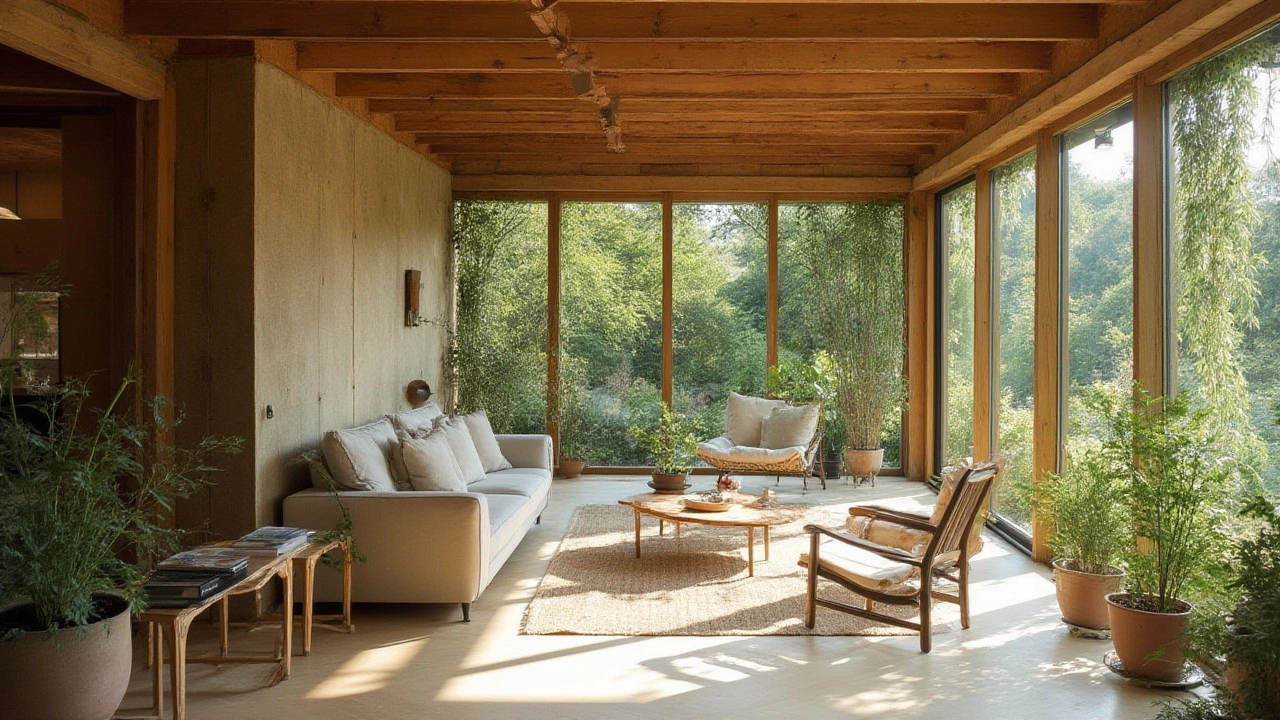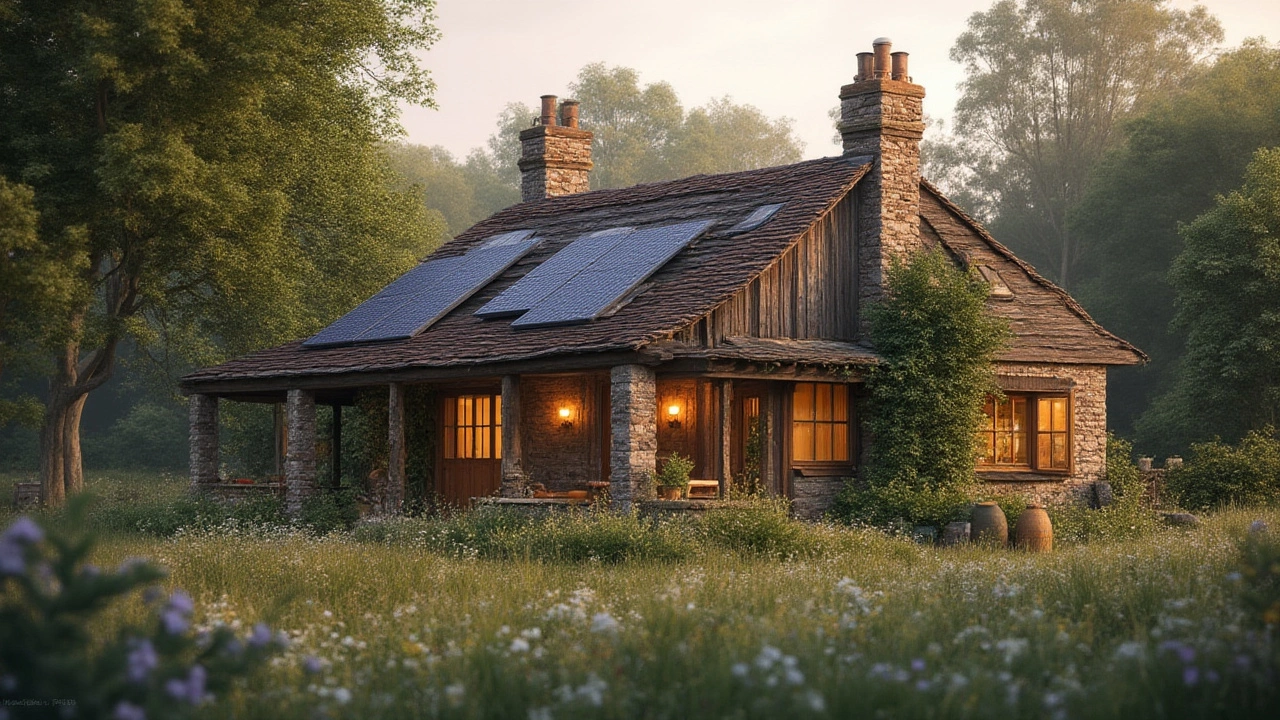Picture this: homes that don’t just look good but actually help the planet breathe easier. Think walls that keep your living space cozy with zero guilt, floors made from stuff that might surprise you, even roofs that filter the air. Sounds almost futuristic, right? Yet, it’s all happening now. As the climate crisis grows louder, the conversation around eco-friendly building materials isn’t just for the crunchy crowd—it’s everywhere. Traditional concrete and steel get the job done, but they’re carbon monsters. Just making cement coughs up more than 7% of global CO2 emissions alone. People are hungry for better options. The hunt for the ultimate green building material isn’t just about creating less waste or lowering bills (though, who minds that?). It’s about creating spaces worth living in and passing on. Ready for the real green secrets behind the walls?
What Makes a Material Eco-Friendly?
So, what does it really mean for a building material to be eco-friendly? First off, it’s not just about recycling leftover junk and calling it a day. An eco-friendly material lowers its impact from start to finish: how it’s sourced, what goes into making it, if it needs tons of energy to produce, what happens when it’s done serving its purpose, and, of course, how it treats our lungs while we live around it.
Let’s break it down. To call something eco-friendly, experts look at:
- Resource extraction: Is it easily grown or mined without wrecking forests or habitats? Bamboo, for example, pops up fast—sometimes over 3 feet a day. Compare that to hardwoods taking decades.
- Embodied energy: How much energy goes into mining, moving, and making it into something you can build with? Rammed earth and straw bales win here—they’re ultra local and need minimal processing, slashing carbon emissions.
- Recyclability and end of life: Can it go back into the earth or the next building? Glass can be melted down again. Hempcrete composts right into your garden. But PVC, not so much—it lingers as toxic waste.
- Indoor air quality: Some materials release nasty things called VOCs (volatile organic compounds). Natural plasters, solid wood, and lime mortars help avoid this, unlike some synthetics or composite boards.
This is where things get tricky. Aluminum, for example, takes tons of electricity to mine but lasts forever and fully recycles. Timber locks away carbon but has to be harvested responsibly. So, the “greenest” material depends on where you live, what you have easy access to, and how the whole building goes together.
For a clearer sense, check out this data:
| Material | Renewable | CO2 Emissions (kg per ton material) | Recyclable/Biodegradable |
|---|---|---|---|
| Bamboo | Yes | 90 | Biodegradable |
| Concrete | No | 820 | No |
| Rammed Earth | Yes | 20 | Biodegradable |
| Recycled Steel | No | 1800 | Recyclable |
| Straw Bale | Yes | 35 | Biodegradable |
| Hempcrete | Yes | 110 | Biodegradable |
It’s kind of wild seeing how something like bamboo stomps concrete and steel for both emissions and end-of-life impact. Meanwhile, recycled steel uses less energy than brand-new steel, but it’s nowhere near biodegradable.
When picking a material, think beyond just the product. How far does it travel to get to your site? Hauling in fancy European cross-laminated timber from 4,000 miles away probably wipes out a lot of its green points. Local always wins extra eco points.
If you want an easy rule: focus on stuff that’s renewable, non-toxic, either reusable or compostable, and doesn’t take a fossil fuel feast to make. Simpler materials, fewer layers, less hidden glue and paint—these all help.

The Top Eco-Friendly Building Materials (And How to Use Them)
Here’s the real dirt: some materials aren’t just greener, they’re downright awesome to live with. Let’s look at the main players for anyone eyeing an eco-friendly build, whether it’s a cozy cottage, a sleek tiny home, or just an addition with a smaller footprint.
- Bamboo: This superstar grows up to a meter a day and matures in 3-5 years. Builders in Asia have used bamboo for ages—think of it as timber’s fast, flexible cousin. It’s tough, resists pests, and doesn’t need much beyond careful drying. Bamboo flooring is on the rise: it’s harder than maple and uses less water and zero toxic glues with some brands. The downside? Some treated bamboo products use strong adhesives and finishes, so always check for FSC-certified or formaldehyde-free options.
- Rammed Earth: It’s literally soil—clay, sometimes gravel—chucked into forms and compressed into thick, solid walls. This method dates back thousands of years and has seen a huge comeback, especially in dry regions like Australia and the American Southwest. Rammed earth walls are natural insulators, use no additives, and age beautifully. They even out temperatures so you use less heating or AC. Tip: go for rammed earth if your plot has the right subsoil. It’s heavy, so not always practical for upper floors, but unbeatable for ground walls.
- Straw Bales: Farm waste, but reimagined as insulation bricks. Straw captures tons of carbon from the atmosphere as it grows, and if sealed well with clay or lime plaster, these bales can last a century or more. Homes built like this are pop-up-proof (some take only a week to stack and finish) and keep energy bills rock-bottom. They’re also cheap and easy to source in many rural areas. Just keep the bales dry; moisture is straw’s only villain.
- Hempcrete: A mix of chopped hemp stalks and lime. It’s as light as popcorn, super breathable, and actually absorbs CO2 as it cures. You see it more often in Europe, but it’s spreading fast in North America. Hemp crops clean the earth as they grow, making the final product extra eco-cool. Fun fact: a cubic meter of hempcrete can sequester up to 165 kg of CO2. Hempcrete is best for non-structural walls; you still need a frame, usually wood or steel.
- Recycled & Reclaimed Materials: From metal to brick, reusing saves energy and landfill. Reclaimed wood (think old barn beams) has serious character and zero extra logging. Roof tiles, bricks, urbanite (broken concrete chunks) can all be repurposed. You don’t just save emissions, you get a look that modern, factory-made stuff can’t touch. Watch out for lead paint or asbestos in salvage—always test before reusing in living spaces.
- Wood (Especially FSC-Certified Timber): If managed well, forests act as carbon banks. FSC certification means wood comes from forests that are regrown or never clear-cut. Wood frames and siding can last decades and lock carbon away for good. Mass timber (cross-laminated timber) is now being used for skyscrapers because it’s stronger, lighter, and stores more carbon than concrete or steel per weight.
- Natural Plasters and Paints: Earthen plaster, limewash, and clay paints come with a tiny eco-footprint, no weird chemicals, and gorgeous, earthy vibes. Unlike acrylic or standard paints, they breathe, preventing mold and keeping air fresh. If you must paint, go for zero-VOC certified brands.
- Cork: Harvested from the bark of living trees, cork comes back every decade or so without cutting the tree down. As a flooring or wall material, it’s springy, silent, and naturally resists moisture and pests. Fun fact: Portugal supplies around half of the world’s cork. Look for “solid cork” boards rather than vinyl-cork mashups for pure eco-benefits.
Quick side tip: Don’t get sucked in by clever marketing. “Greenwashing” happens a lot—manufacturers slap on eco-labels with little to back them up. Look for meaningful third-party certifications: FSC for wood, GREENGUARD for air quality, Cradle to Cradle, or SCS Global for building ingredients. It’s not paranoia; it’s just smart shopping.
Mix and match these materials depending on where you live. In dry climates, earthen walls sing. Wet and cold regions? Straw bales need protection, but FSC wood or hempcrete with lime plasters work wonders. Modular green panels are gaining speed, especially for urban projects starved for space. There’s no universal “winner”—using the most eco-friendly building materials for each job is the real trick.

Life Hacks, Myths and the Real-World Impact of Green Building
Here’s where the magic happens: people actually living in green homes report some pretty cool perks, not just for the planet but for their health, wallet, and comfort. Let’s bust a few myths and serve up some tips from real builders and homeowners.
- Eco-friendly DOESN’T always mean more expensive. While fancy prefab panels cost more upfront, basics like straw bales, natural plaster, and recycled wood can be dirt cheap, especially if you DIY or source locally.
- If you’re worried about durability, check out histories: rammed earth and timber houses have lasted centuries, literally. The oldest standing bamboo homes in Asia are pushing 200 years.
- Air quality isn’t a buzzword—it’s huge. Studies from Harvard and Berkeley found people living in houses with all-natural finishes and no plastics or VOCs reported 60% fewer headaches, respiratory symptoms, and allergies.
- Energy bills can drop by 30-70% just by combining tight insulation (think thick straw, hemp, cork) with smart window placement and good orientation. That means money back in your pocket after a few years, not decades.
Feel overwhelmed? Here’s a cheat sheet for getting started:
- Pick two or three green materials based on what’s locally available. Search local farms for straw or hemp, salvage yards for timber, or co-ops for earth and lime products.
- Work with a builder who gets green design—or is open to learning. It helps avoid rookie mistakes (like letting straw bales get soaked in the rain).
- Keep the structure simple. Fewer finishes, fewer layers, less waste.
- Research tax breaks and incentives for eco-friendly materials or energy upgrades. Most regions now offer cash, rebates, or lower permit fees for low-carbon buildings.
The coolest part? Living in an eco-friendly home feels different. You’re not just ticking boxes for the planet—you sleep better, breathe easier, and face fewer maintenance headaches from peeling paint or weird mold. Friends will ask how you managed that cozy warmth in winter and cool in summer (thank straw and earth walls for that). You get to say your bedroom walls used to be someone’s field, or your kitchen benches once held up a barn, and watch their jaws drop a bit.
The next generation of buildings isn’t some high-tech fantasy. It’s rediscovering ancient wisdom—using what grows and lasts, not what pollutes for centuries. So, if you’re dreaming of a home that gives back to the earth instead of draining it, you’ve got way more choices than you think. Start small if you want: even a single cork floor or earthen accent wall makes a difference. Building green isn’t about perfection. It’s about real choices, smart trade-offs, and a space that feels right for you—and maybe a little kinder to the wild world outside your window.
